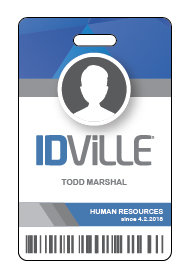
Identification (ID) cards have become an essential component of facility and workplace safety, and it's nearly impossible to walk into a workplace without one. Organizations equip employees with ID cards to easily identify who does and does not belong in the building and to streamline personnel processes.
ID badges can play a pivotal role in an organization's security plan, and creating the right card is imperative to achieving security goals. By considering the following ten ID card components, organizations can create the perfect ID card to meet their needs.
1. ORGANIZATION LOGO
Add a visual security element to ID cards by incorporating your organization's logo. Be sure your ID card design is consistent with the current marketing style sheet, including font, logo, and colors to reinforce the brand's message and project a professional image. A corporate logo is a highly recognizable image for employees and security personnel. To truly protect your cards against forgery, add HoloKote capabilities to your printer. HoloKote adds a holographic overlay of your custom logo that can be seen when your ID card is turned at an angle. By incorporating your logo into the ID card design, it will be more difficult for fraudulent cards to be created.
2. DESIGN
An effective ID card design is both attractive and functional, and your card design can be just as important as the security features it encompasses. Time should be invested into the design of your ID card to ensure it meets all of your security and branding needs. The card design itself can also provide valuable information using colors and graphics. For instance, hospital ID cards often assign a specific color to different floors or departments, making it simple to identify where employees work. The color bar system can also designate various security clearances.

3. SINGLE- AND DUAL-SIDED
Depending on what security or data features are included, ID cards can be single- or dual-sided. Determine what ID card functions are priorities for the organization and consider how much space will be needed. A dual-sided card can include a lot of information and features without sacrificing design. With a dual-sided card, you also have the ability to add important information to the back of the card, such as a mission statement or emergency contact numbers.
4. ORIENTATION
ID cards can be displayed horizontally or vertically, and the orientation of your ID cards will impact how they are worn by employees. Consider the different scenarios where ID cards will be used. If employees interact with customers on a daily basis, your ID cards should be designed as a marketing piece with the employee’s name able to be read easily by customers. If employees need to swipe cards for time and attendance or access control, that may also impact the orientation.
5. EMPLOYEE PICTURE
It is standard for ID cards to include a picture of the employee on the front of the card. The photo on an ID card makes it unique to the individual employee and should be easily visible. Photo identification is normally used on identification documents, such as a driver's license, passport, or ID card, to increase the security and authenticity of the document. Government personnel verify identity documents by examining both the card and the card carrier. Likewise in the workplace, security and authority personnel should use a similar verification process with employee photo ID cards.
6. DURABILITY
ID cards made of durable materials, like PVC, or plastic HID smart cards, require fewer reprints and can last up to five years. These long-wearing materials have been proven to last long after paper ID cards are in the recycle bin. They are also more difficult to copy since an ID printer is required to print a PVC card, whereas a paper ID card can easily be recreated on a PC home printer.
7. DATA ENCODING
ID cards, at their best, include encoded information about the user with the use of barcodes, magnetic stripes, RFID tags, and smart chips. These features allow an organization to sync their identification with building access or time and attendance programs. Combined with a card reader to approve or deny admittance, these encoded cards relieve an organization from staffing security personnel in critical areas – ultimately saving money.
8. SIGNATURES
When a photo isn't enough to visually identify an employee include a copy of the authorized employee's signature printed on the ID card. Even trained professionals have a hard time duplicating a signature on the spot. When someone's identity is in question, having this visual security reference printed right onto the ID cards is an instant way to detect a fraudulent ID card or unauthorized visitors.
9. ENHANCED SECURITY
For some organizations, enhanced security is a desired quality of employee ID cards. Various enhanced security features can be added to ID cards with the proper equipment and software. A non-replicable fingerprint or holographic overlay can both be added to your cards to make them more secure and less prone to fraud.
10. PERSONAL INFORMATION
An ID card has a limited amount of space, so the personal information displayed needs to be purposeful. Because employees will display their ID cards every day, the cards can be an effective vehicle for communicating job-related certifications. However, always check with organization and industry security standards for disclosure guidelines. Many organizations in the service and healthcare industries do not put employee last names on their ID cards to protect their privacy.
These ten components make up great ID badges. If you need more information or any assistance in creating your ID badges, contact an ID System Specialist at 1.866.438.4553.